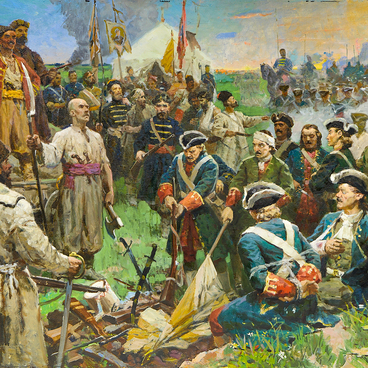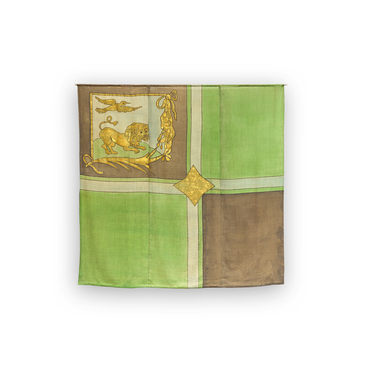The painting “Apotheosis of Peter the Great” presented in the museum’s collection is an example of an allegorical depiction of a significant historical event. It represents the day of victory of the Russian army, led by Peter the Great, over the Swedes at the Battle of Poltava in 1709.
In the same year, 1709, Daniil Golyakhovsky, impressed by this victory, created the engraving “The Apotheosis of Peter.” The victorious tsar was depicted on horseback with a drawn sword in his hand, overshadowed by the wings of a soaring angel. Under the hooves of the horse is a defeated lion, the symbol of Sweden. To the right of Peter the Great is a group of Swedish officers extending their swords hilt-first as a sign of defeat.
Subsequently, the image from the engraving became the basis of a number of paintings. One of them was created in the settlement of Borisovka by icon painters.
The emergence of icon painting in Borisovka is associated with the establishment of the Bogoroditsa-Tikhvin Convent in the settlement to commemorate the victory in the Battle of Poltava. The monastery was founded by Count Boris Petrovich Sheremetev, who owned the lands of Borisovka settlement and was one of the closest associates and the first commander of Peter the Great. To teach the peasants of Borisovka icon painting, Sheremetev sent experienced painters from St. Petersburg to Borisovka. Gradually, Borisovka icon painting gained wide recognition.
The geographical spread of Borisovka icons was extraordinarily wide: the Kursk, Kharkiv, Poltava, Yekaterinoslav, Rostov, and Taganrog provinces; the Don, the Azov region, Kuban, the Caucasus, even Bulgaria and Serbia.
A copy of the work of Borisovka masters was made in the 1960s. Its peculiarity is the absence of images of angels and other allegorical figures of a religious nature. All the attention of the viewer is drawn to the figure of Peter the Great, whose generalship talent and personal courage played a huge role in the victory at Poltava. The painting predominantly features rich red and brown tones, emphasizing the solemnity of the moment: the Poltava victory was a triumph of Peter the Great’s time. Peter I was proud of the main battle of his life. “An unheard-of victory in the world, ” “the Russian resurrection, ” “the beginning of our salvation and prosperity” — that’s how he described it.
The significance of the Battle of Poltava was
enormous, in military, foreign, and domestic political terms, as well as
historically. The Battle of Poltava not only glorified Russian arms for
centuries, but, like the battles of Kulikovo, Borodino, Stalingrad, and Kursk,
became a symbol of the resilience and bravery of the national character,
forever becoming a moral support for the self-awareness of the people in times
of hardship. It has eternally become a source of national pride.


